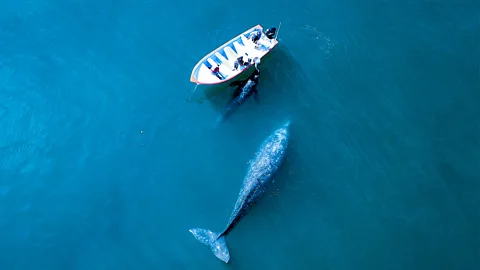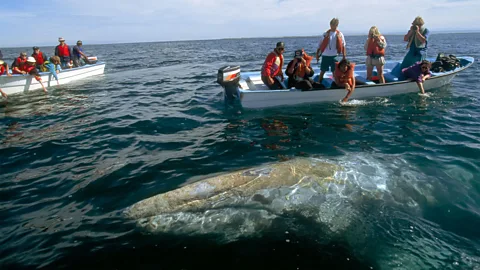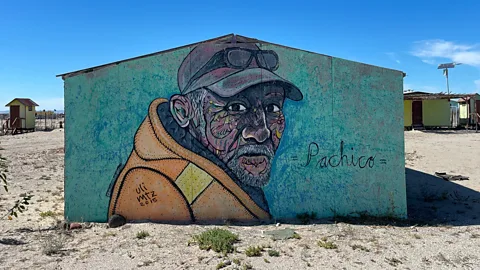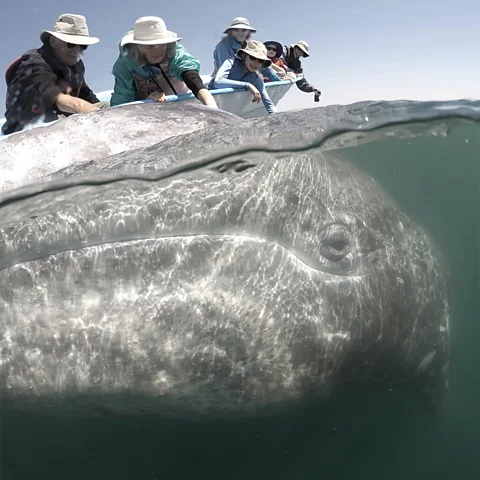
Once nearly hunted to extinction, Pacific gray whales in Mexico’s Laguna San Ignacio now seem to be as curious about us as we are about them.
“Here she comes again!” our guide, José Sanchez, announces as a massive grey whale approaches us for the fifth time in 45 minutes. Each time our curious new friend returns to our idle fishing boat, it stays a bit longer on the surface, watching us as we watch her.
This is our final outing to see what locals call “the friendlies” – the gray whales in Mexico’s Laguna San Ignacio. As our boat quietly sits with its engine off, this 40-ton whale playfully rubs up against the sides of the boat, raising the top half of its white-speckled body and cosying up right along the hull as if to check out all six of us onboard. When the whale’s eye – which is about the size of a baseball – breaks the surface and meets mine for a moment, I shriek with delight. you want to advertise your article
We’re told to give whales distance, but what happens when they come to watch us?
Located on the western coast of Baja California Sur’s peninsula, the Laguna San Ignacio is considered the last undisturbed breeding and calving lagoon of the Pacific grey whale. The protected whale sanctuary is also home to one of the world’s most unusual wildlife encounters: here, curious whales regularly, and voluntarily, seek out contact with humans.

Every year from January to mid-April, thousands of gray whales arrive in the lagoon during a 19,300km journey from the icy waters of the Arctic to the warm waters of Baja California Sur to mate and give birth. While these are now safe waters for nursing and breeding, gray whales were once hunted here. Yet, the animals now seem to have learned to trust humans. In fact, during my recent whale-watching trip with Sanchez’s eco-tourism company Pure Baja Travels, we witnessed mothers bringing their calves over to boats to present them like proud parents.
These unique encounters have influenced the conservation and protection of these gentle giants and spurred a thrilling – and responsible – whale-watching experience like nowhere else.
Why do Baja’s gray whales seek out human contact?
For more than 50 years, gray whales in Baja have shown they seem to be as curious about us as we are them. Marine biologists believe a combination of circumstances contribute to this unique behaviour.
“In the lagoon, today, there are no real threats,” says Dr Steven Swartz, a cetacean researcher who has been studying gray whales at Laguna San Ignacio for 45 years. While gray whales have been known to occasionally approach humans elsewhere, according to Swartz, this is the only place where they regularly do so, and where the animals linger and often rise above the water’s surface, allowing humans to touch them.

Whale-watching is only permitted in a specific “zone” of the protected whale sanctuary, and there are strict rules: only 16 pangas (small fishing boats) are allowed in this zone at a time. To not overwhelm the whales, all boats must turn off their motors when whales approach. And most importantly, boat operators don’t chase or pursue the whales.
“[Guides] put you in the presence of the whales, and let the whales decide if they’re going to come over, and say hello or not,” says Swartz.
But why do the whales seem to come and say hello? “Mammals are curious; they are sentient enough to learn about their environment, and they learn by exploring,” Swartz explains, adding that mothers pass on this curiosity towards boats and people to their calves. “[The whales] are capable of remembering.”
Whales, in general, are very tactile; they like to rub and touch; that’s how they communicate, Swartz says. Pacific gray whales aren’t busy looking for food (they do that in the Arctic), so perhaps they’re also bored, he suggests. While we cannot know exactly why the whales do what they do, Swartz and other marine biologists all agree the whales approach the boats voluntarily.

A model for community-driven conservation
Gray whales were nearly hunted to extinction during the 18th and 19th Centuries, and as a result, the animals tended to act aggressively towards humans – so much so that local fishermen even dubbed them “devil fish” and avoided them. But in 1972, a man named Francisco (Pachico) Mayoral was out fishing in Baja when a whale surfaced and lingered by his boat. Curiosity compelled him to put his hand in the water. The whale rubbed against Mayoral and stayed by his hand.
News of Mayoral’s experience spread, and locals, much less afraid, waited patiently to experience similar friendly encounters. “Gray whales specifically are naturally curious and have never been afraid of approaching floating items in the water. Humans hurt them, and then the gray whales reacted to that interaction,” Sanchez tells me. “After [Mayoral’s] first peaceful contact, humans started to realise gray whales are not the scary and mad animals we thought they were.”
Sanchez was the first Mexican naturalist to guide whale-watching tours in the lagoon back in the 1990s, and his own eco-tourism company now has a base camp on San Ignacio Lagoon. “As time has gone by, humans are becoming less afraid to let gray whales get closer to the point of close contact. I believe this is [also true for gray whales].”
In 1972, the Mexican government created the San Ignacio Lagoon nature reserve, and in 1988, declared the lagoon a whale sanctuary within El Vizcaíno Biosphere Reserve, the largest wildlife refuge in Latin America. Five years later, it was designated as a Unesco World Heritage Site. The gray whale population recovered and was removed from the endangered species protection in 1994.

That year, Mayoral tipped off environmentalists that Mitsubishi and the Mexican government were planning to build a massive salt factory within the nature reserve. The salt mine was thwarted in 2000 by a robust effort from the local and international community – drawing activists from Robert F Kennedy Jr to actor Christopher Reeves to Baja’s shores to join the protest. Today, the battle to save Baja’s gray whales is considered one of the greatest wildlife conservation success stories of our time.
Mayoral passed away in 2013, but he’s been referred to as the “saviour of gray whales” and the grandfather of whale-watching in Baja. Ever since his first peaceful encounter, visitors and locals alike have sought out a similar experience in Baja the lagoon. In fact, Mayoral’s family is still running whale-watching trips.
More like this:
• An ethical – and safe – place to swim with whales
• The hidden wonders of Mexico’s sacred underwater world
• Thirteen photos that will make you care about the ocean
Today, the human-whale encounters in the San Ignacio Lagoon have not only fuelled conservation efforts but also inspired a regulated eco-tourism industry, which provides a meaningful source of income to local communities.
“Eco-tourism is the economic basis for the community. [The people here] watch over the lagoon and whales, and work together to coordinate sustainable whale-watching so that they don’t destroy or overuse the resource that’s providing income for them: the whales,” says Swartz.

On Pure Baja Travel’s five-day trips, travellers embark on six whale-watching outings (which give the animals more opportunities to come to you on their own terms) while also learning about the community’s conservation efforts in the lagoon. The camp is only open in February through March and then it disappears when the animals migrate in April.
From our tented base camp right on the banks of the lagoon, I awoke nearly every morning to the rumbling sounds of whales in the distance and could see their heart-shaped vapour spouts as we ate dinner. To be sleeping right along their sanctuary was almost as exciting as seeing them an arm’s distance away during the day.
A new generation steps up to save Baja’s gray whales
While the San Ignacio Lagoon where the gray whales give birth is now protected, continuing to safeguard the animals and support the local communities who guard them is more vital than ever. Climate change is now impacting the lagoon and the gray whales on their migratory path.
Mexican climate activist Xiye Bastida hopes to inspire a new generation to step up and take action by co-producing and starring in a documentary that will be released in the coming months called The Whale Lagoon. At 22 years old, Bastida connects the grassroots conservation efforts that started a generation ago to the climate crisis facing this generation. She joined WildCoast, an international nonprofit organisation that has been a leading force in the gray whale conservation efforts for more than 25 years, to amplify the voices of the community.

WildCoast’s co-founder and executive director Serge Dedina worked to permanently protect 450,000-acres of San Ignacio Lagoon habitat in 2004. helped to successfully lobby the Mexican government for San Ignacio Lagoon to be included in the El Vizcaíno Biosphere Reserve, the largest wildlife refuge in Latin America, back in 1988. Now he says Laguna San Ignacio is a global model showing how to protect wildlife while creating sustainable development. The organisation helps to train ecotourism guides, enhance outreach and expand women-led mangrove restoration programmes that help fight climate change.
With the climate crisis affecting the migratory path of the whales, the restoration of mangroves (which sequester 10 times more carbon than tropical forests) is another battle Laguna San Ignacio area residents are fighting every day, along with needing to regulate development and tourism around the lagoons.
“There’s something about the whales that makes you feel overwhelmed, with almost a responsibility to take care of them. When the whale pushes up her calf so you can touch it, that is an immense amount of trust,” Bastida tells BBC.
“We call them the friendly whales, but I think they are the conscious whales, and they want us to be more conscious and more in touch,” she adds. “I hope that if people see the film or if they are fortunate to see the whales, they can find a piece of themselves they didn’t know they had – an instinct to protect [them].”